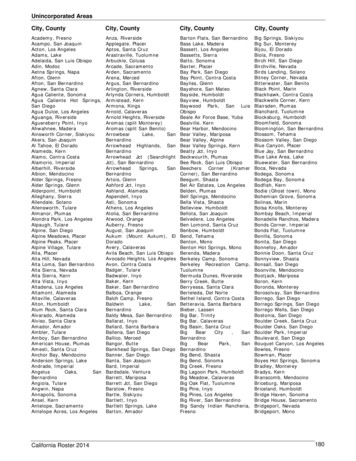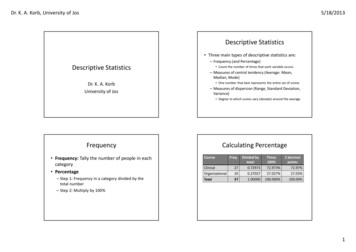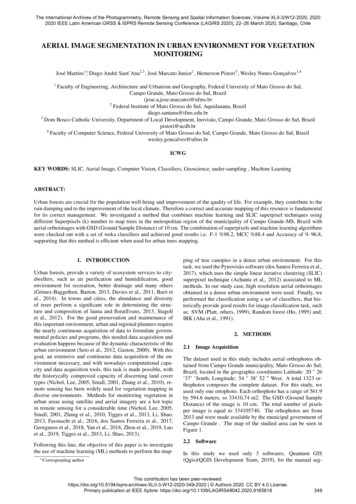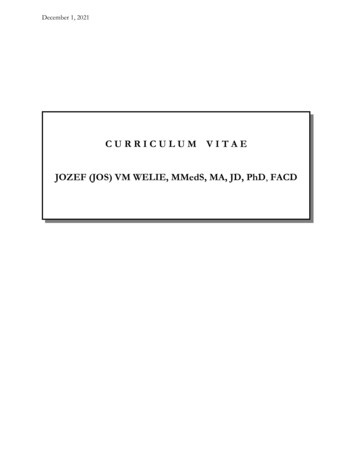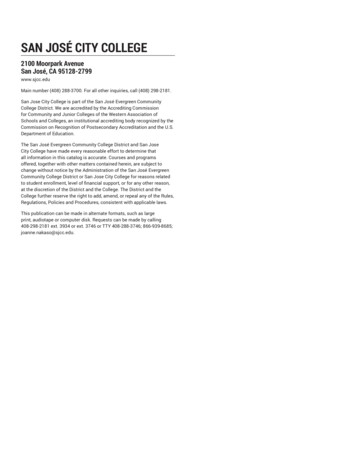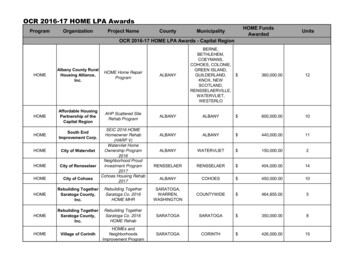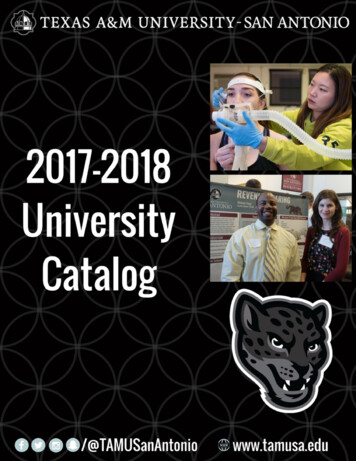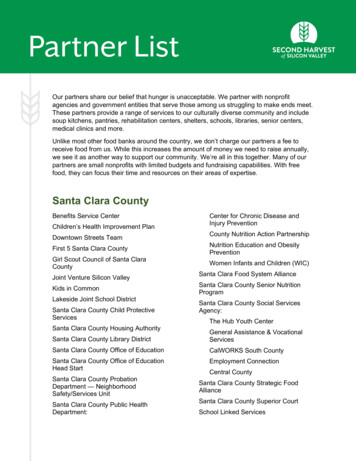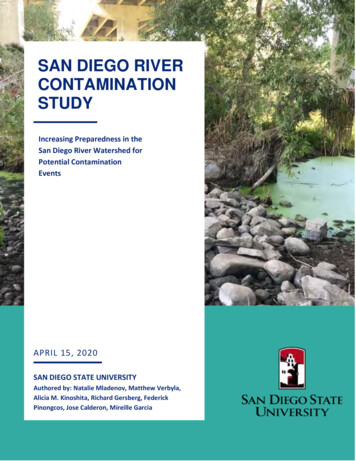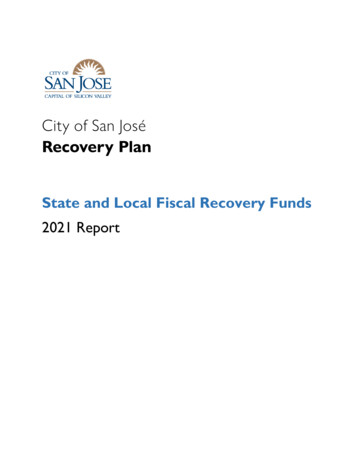
Transcription
City of San JoséRecovery PlanState and Local Fiscal Recovery Funds2021 Report
TABLE OF CONTENTSGeneral Overview . 1Executive Summary . 3Uses of Funds . 5Revenue Loss Replacement (EC 6) – General Fund . 16Revenue Loss Replacement (EC 6) – Convention and Cultural Affairs Fund. 17Promoting Equitable Outcomes . 19Community Engagement . 22Labor Practices . 23Use of Evidence . 25Table of Expenses by Expenditure Category . 26Project Inventory . 27Resident Relief Initiatives . 28Eviction Help Center . 29South Hall Demobilization Housing Assistance Center . 30Hotel Sheltering Operations Services . 31Continued Food Services . 32Food Distribution Resilience Corps . 33Environment Resilience Corps . 35Guadalupe River Park Coyote Creek Clean-Up Resilience Corps. 37Learning Resiliency Corps . 39Small Business Resilience Corps . 41Small Business, Non-Profits, and the Arts Initiatives . 42Supplemental Business Development Communications . 43Quetzal Gardens Business Center . 45Downtown Outdoor Activities Marketing Campaign . 47Supplemental Economic Development Association Capacity Building. 49Small Business Anti-Eviction Assistance . 51Supplemental Arts Cultural Funding . 53Support Festival Programming. 54Small Business Grants . 55Virtual Business Center . 57Small Business Technical Assistance Refresh . 59Small Business Direct Outreach (Spanish Vietnamese) . 61Storefront Activation Grants . 63Downtown Pedestrian Quality of Life Streetscape Improvements . 65San José Al Fresco . 67Small Business Displacement Index Study . 69 i
Building Resiliency: Property Business Improvement Districts . 71Small Business Manufacturing Recovery Initiative . 73San José Abierto . 75Emergency Public Information . 77City Manager's Office Recovery Team . 79COVID-19 Recovery Taskforce Community Engagement . 80Child Care and Education Initiatives . 81Digital Equity Communications, Outreach Community Engagement . 82Community WIFI . 83Device Access . 84Data Equity Lead . 85Continued Child Care Services . 87San José Learns . 89Family, Friend & Neighborhood Program . 91Child and Youth Success. 93Emergency Housing Initiatives . 95Homeless Services Outreach Assistance Resources (SOAR) Program . 96Site Identification Construction . 97Encampment Services/Beautify SJ Initiative . 98BeautifySJ Consolidated Model . 99BeautifySJ Grants . 101Vehicle Abatement Program, Proactive Patrol, Complaint Response . 102Downtown Automated Public Toilets . 103SJ Bridge Public Restrooms . 104Recovery Foundation Initiatives . 105Hybrid Workplace . 106Omnichannel Strategy, Process Engineering, and Service Delivery Automation . 108OneCity Workplace . 111Recovery Recruiting & Hiring . 113Safe Workplace . 115Other City Initiatives . 116Energy-Saving Retrofits . 117San José Aspires Administrative Support . 119YIGBY Land Use Policy Development . 121 ii
GENERAL OVERVIEWNo event in living memory has been more painful or traumatic for the people of the City of San José(“City”) than the COVID-19 pandemic and the subsequent economic crisis, which laid bare andexacerbated existing inequalities. In this moment, the City’s biggest challenge and biggest opportunity isto foster an equitable recovery to a “Better Normal”. The journey to healing, recovery and resiliencewill require unprecedented effort, resources, and creativity across our community and organization.Recovery is not for us to do alone; rather, this work must be done with the whole community, for thebenefit of those most burdened by the crisis, guided by their wisdom, tapping into their potential, andbuilding on their deep enduring strength.Now, the City is transitioning the organization from an Emergency Response environment, with a fullyactivated Emergency Operations Center (“EOC”), to the beginning of Community and EconomicRecovery. Integrating community-wide recovery efforts into the City organization has entaileddemobilizing most of the EOC while continuing its response to COVID-19 surges, and transitioningcommunity and recovery functions into City departments. This is a large and complicated re-alignmentof City service delivery that is almost as difficult as the COVID-19 Pandemic response itself – spanningeighteen (18) San José City Roadmap initiatives (Figure 1) with fifty-three projects 1 that will touch everyCity department.Figure 1. City Roadmap: Eighteen (18) Recovery InitiativesThe American Rescue Plan (“ARP”) Act included 212.3 million in Coronavirus State and Local FiscalRecovery Funds (“CSLFRF”) in direct local recovery assistance for the City, of which 106.1 million was1Please note: “Workstream (“Project”)” has been used interchangeably with “project”; workstream is Cityterminology.PAGE 1 122
received in May 2021; the remainder is expected by June 2022. The 2021 City Recovery Plan for Stateand Local Fiscal Recovery Funds (“City Recovery Plan”) includes an initial 131 million allocation ofCSLFRF monies to support an incremental – though still substantial – assignment of resources forcommunity and economic recovery initiatives for FY2020-21 and FY2021-22. The CSLFRF funds, whencombined with other City funds, will be used to strategically deliver the respective projects within CityRoadmap initiatives to help the City fully recover and return to that “Better Normal”. The CityRecovery Plan will be revisited and reallocated as City priorities and/or the CSLFRF program require.PAGE 2 122
Executive SummaryThe initial City of San José Recovery Plan State and Local Fiscal Recovery Funds 2021 Report (“CityRecovery Plan”) demonstrates the City approach to funding a transition to Community and EconomicRecovery that centers our collective efforts on: WHAT work is most important as defined by the San José City Roadmap and the eighteen (18)COVID-19 related initiatives the San José Mayor and City Council have prioritized, from housingstabilization to building back better. (City Roadmap)WHO we are doing this with and for is with our capable partners to ensure collective impactand for the people who have been most burdened, particularly Latino/Latina/Latinx and otherpeople of color as well as women, seniors, differently-abled, and low-wage workers and smallbusiness owners. Seeing them not only as clients with needs, but as partners with strengths andpotential. (Equity)WHERE we need to ensure the most change is predominately in the neighborhoods on theEast Side and areas around Downtown, the neighborhoods with the highest rates of COVIDinfection and death, and the highest rates of unemployment and financial distress. (Place-Based)The City must remain fiscally sound if we are to continue to support the lives and livelihoods of thepeople and businesses of San José into the future. This means a substantial amount of Federal and Stategovernment recovery funds will go not only to addressing the ongoing economic and public health crisescreated and, in some cases, intensified by the COVID-19 Pandemic, but also to supporting the GeneralFund and other City funds, thereby preserving the City’s organizational budgetary stability and widerange of long-established community services. After receiving City Council feedback during the City’sFY2021-22 Budget Study Sessions, and working with staff to understand available funding and projects,this City Recovery Plan allocates an initial Community and Economic Recovery Budget with confirmedfunding sources, including CSLFRF monies, based on the City Roadmap eighteen (18) recovery initiativesand ensures funding for: Critical safety net services;Projects where City must lead and execute;Foundational work such as planning, hiring/procurement, fiscal accountability and transparency,communication/language and community and partner engagement;Other key initiatives described in the City Council-approved Mayor’s March Budget Message forFiscal Year 2021-2022; andMitigation of revenue shortfalls in City funds to ensure continuity of services.This approach allowed for flexibility and partnering opportunities and needed time to continue torigorously pursue, understand, and unlock additional State and Federal government funding programs. Itallowed the City to immediately initiate planning, hiring, procurement, and other long lead items, so theCity did not miss the opportunity to drive change. Starting this past summer 2021, the City: Continued providing critical safety net services, developing hand-off plans with partners wherepossible, making sure we do not leave anyone behind;Listened to people and businesses most burdened to center the work in their lived experience, andtaking the time as leaders to reconnect with the community and give teams the ability to refine ourapproaches and strategies based on what we learn;PAGE 3 122
Engaged with partners to develop a collective impact approach to recovery that plays to strengths,to make sure we have the opportunity and the ability to do something truly transformational;Developed and launched equity-focused, place-based, recovery initiatives that direct our efforts onwho and where it is needed most;Continued to pursue, understand, and unlock additional State and Federal government fundingprograms, to maximize funding coming to us and our partners; andEnsured accountability and transparency in funding.City staff also will return to its Council on a regular basis for guidance, direction and additional budgetadjustments as required – including taking the time to work with Council Committees, and givingCouncil ample and repeated opportunities to set and shape policy and strategic direction for each ofthe eighteen (18) City Roadmap initiatives. As noted above, the City Recovery Plan will be revisitedand reallocated as City priorities and/or the CSLFRF program require.PAGE 4 122
Uses of FundsThis City Recovery Plan presents an incremental – though still substantial – allocation of resources forcommunity and economic recovery initiatives. In order to manage resource allocation and prioritizationat a more granular level, each of the eighteen (18) Recovery Initiatives was broken down into projects.These projects are graphically shown in Figure 2 below. Funding for the projects (“workstreams”) inFigure 2 was prioritized using a racial equity lens, which is described in detail in the Promoting EquitableOutcomes section below.Figure 2 Projects (“Workstream (“Project”)s”)The City Recovery Plan Uses of Funds is presented in seven (7) groupings of Roadmap initiatives. These“Groups” reflect a thread that relates to the common outcomes, objectives, communities, and/orpartners. These seven (7) Groups are:1. Resident Relief – comprised of the Housing Stabilization, Re-employment WorkforceDevelopment, and Food Necessities Distribution Initiatives;2. Small Business, Non-Profits, and the Arts – comprised of Small Business Recovery andBuild Back Better Recovery Task Force Initiatives;3. Child Care and Education – comprised of Digital Equity; Child Care Learning Pods; Family,Friend, and Neighborhood Program; and Child and Youth Success Initiatives;4. Vaccination – comprised of the Vaccination Taskforce Initiative;5. Emergency Housing – comprised of the Emergency Housing Construction and Operations,Sheltering Enhanced Encampment Services, and Encampment Management Safe RelocationPolicy Initiatives;6. Encampment Services/Beautify SJ – comprised of the Encampment Waste Pick-up BeautifySJ Initiative; andPAGE 5 122
7. Recovery Foundational Enterprise Priority – comprised of Federal State Stimulus,Continuity of City Services, Safe Workplace, Employee Health, Drive to Digital, and EffectiveTeams Initiatives.The mappings of these Groups and Initiatives in the City Roadmap are visually represented in Figure 3,City Roadmap, Groups, and Initiatives Mapping.Figure 3 City Roadmap, Groups, and Initiatives MappingThe tables below display the following information:1) Group. Budget allocations are at the Group and City Roadmap Initiative level to provide flexibilityto respond to changing conditions and feedback from community engagement. Each Group containsone or more City Roadmap Initiatives. Initial Funding – this amount is budgeted in FY2021-2022 with the CSLFRF monies and otherknown funding sources. Total Funding Gap – this is the estimated amount needed later in FY2021-2022 and in futureyears. Likely funding sources to close this gap will be evaluated in calendar year 2021 and willinclude other programs from the American Rescue Plan Act, funding from the State ofCalifornia, or additional CSLFRF allocations. While already federally appropriated CSLFRFresources could close the FY2021-2022 funding gap of 28.3 million if no other resourcesbecame available, CSLFRF would not be able to fully cover the Future Year funding gap of 64.7 million. Therefore, the City’s pursuit of additional funding sources is critical. Total Estimated Cost – this is the total estimated Group cost over a multi-year period and isthe sum of Initial Funding and Total Funding Gap.2) City Roadmap Initiative. The FY2021-2022 total initial budget allocation – the sum of budgetallocations with CSLFRF monies and City emergency reserves – is displayed for each City RoadmapInitiative. Each Citywide Roadmap Initiative contains one or more projects.PAGE 6 122
3) Projects. Individual projects funded with the initial 2021-2022 budget allocation are identified andbriefly described, along with an estimated cost, and are listed in priority order.PAGE 7 122
City Roadmap Initiative(2021-2022 Initial Funding)Resident Relief (Group)Housing Stabilization( 26,286,000)2021-2022 ARP Initial Funding:2021-2022 Other Initial Funding:2021-2022 Total InitialFunding:2021-2022 Funding Gap:Future Years Funding Gap:Total Funding Gap:Total Estimated Cost: 39,249,000 24,527,000 63,776,000Food NecessitiesDistribution( 21,600,000) 16,575,000 22,382,000 38,957,000 102,733,000Re-Employment WorkforceDevelopment( 15,890,000)Workstream (“Project”) (in priority order)(2021-2022 Initial Funding)Emergency Rental Assistance (Housing)Launch federal Emergency Rental Assistance Program in partnership with Homeless Prevention Systemand Santa Clara County ( 14,511,000, which is rebudgeted from 30.4 million received in 2020-2021)Eviction Help Center (Housing)Provide legal services and education for tenant information and resources ( 3,100,000)Isolation Quarantine (Housing)Provide isolation and quarantine services to residents toward mitigating community spread of COVID19 ( 1,125,000)South Hall Demobilization Housing Assistance Center (Housing)Allow for demobilization of South Hall by opening a Housing Assistance Center to work with South Hallclients on the transition to alternative housing options and provide temporary housing assistance( 3,550,000)Hotel Sheltering Operations Services (Housing)Provide hotel sheltering operations and services through purchased hotel properties ( 4,000,000)Continued Food Services (PRNS)Food assistance program with focus on essential grocery, prepared and shelf stable meal programs inprioritized neighborhoods; many of the local food and necessities distribution programs activated duringthe pandemic remain necessary and essential programs of last resort as the economy and ourcommunity recovers ( 21,600,000)Vaccine Champions Resilience Corps (OEM)Provide logistical support at County vaccine sites with 200 “Vaccine Champions” ( 1,840,000)Food Distribution Resilience Corps (PRNS)Support Second Harvest Food Bank food boxing program with 120 individuals from the San JoséConservation Corps ( 6,400,000)Environment Resilience Corps (PRNS)Undertake environmental stewardship projects such as tree planting, defensible space and fuelreduction, biofuel maintenance, and trail maintenance, including community engagement and organizing,with individuals employed or hosted by San José Conservation Corp and other strategic partners( 3,760,000)Guadalupe River Park Coyotes Creak Clean-Up Resilience Corps (PRNS)Support varying levels of clean up, landscape maintenance and stewardship along the Guadalupe RiverPark and Trail and Coyote Creek system and aligned parks ( 1,400,000)Learning Resilience Corps (Library)Provide accelerated learning growth and extended education support at schools, non-profits, and Citylibraries to assist younger youth in recovering with learning during the COVID-19 pandemic( 1,370,000)Small Business Resilience Corps (OED)Provide training in technology areas as such social media, digital marketing, e-commerce, and websitedesign and provide case management and supportive services to the youth, placing and applyingtechnological skills with small businesses impacted by the COVID-19 pandemic ( 1,120,000)PAGE 8 122
Small Business, Non-Profits, Arts (Group)2021-2022 ARP Initial Funding:2021-2022 Other Initial Funding:2021-2022 Total InitialFunding:City Roadmap Initiative(2021-2022 Initial Funding) 16,635,000 0 16,635,0002021-2022 Funding Gap:Future Years Funding Gap:Total Funding Gap: 4,750,000 8,350,000 13,100,000Total Estimated Cost: 29,735,000Small Business Recovery( 14,635,000)Workstream (“Project”) (in priority order)(2021-2022 Initial Funding)Supplemental Business Development Communications (OED)Enable materials creation and translation, digital engagement, small business hotline, email, webinars,and other digital outreach ( 300,000)Quetzal Gardens Operations (OED)Operational funds to support standing up the Quetzal Gardens small business center in East San José( 75,000)Downtown Outdoor Activities Marketing Campaign (OED)Support decentralized outdoor downtown activities and direct marketing campaigns ( 200,000)Supplemental Economic Development Association Capacity Building (OED)Support needs of business district capacity building program through events, advocacy, and marketing( 1,000,000)Supplemental Legal Assistance for Tenant (OED)Support for tenants impacted by the pandemic and facing eviction in the form of legal assistance( 150,000)Supplemental Arts Cultural Funding (OED)Supplement arts and cultural funding to programs experiencing decline in Transient Occupancy Tax(TOT) funds and closure threat ( 2,000,000)Support Festival Programming (OED)Help revive struggling arts organization and re-engage audiences to downtown through support festivalprogramming outlined in the Mayor’s Budget Message ( 200,000)Small Business Grants (OED)Provide up to 100 awards for 25k grants to small businesses plus a 10% admin cost ( 2,750,000)Virtual Accelerator Program for New Businesses (OED)Build a virtual accelerator to support new small business ( 175,000)Small Business Technical Assistance Revamp (OED)Redesign of the Business Owner Space to deliver a curated experience for small businesses seekingtechnical assistance ( 125,000)Small Business Direct Outreach (Spanish Vietnamese) (OED)Enable direct outreach to small business in Spanish and Vietnamese through 2 Executive Analysts( 300,000)Storefront Activation Grants (OED)Eliminate barriers for small business seeking to transform empty spaces into vibrant shops andrestaurants ( 200,000)Downtown Pedestrian Quality of Life Streetscape Improvement (OED)Enable downtown quality of life and streetscape improvements through safety, lighting, activation, andillumination ( 100,000)San José Al Fresco (OED)Transition of temporary parklets located in on-street parking spaces topermanent parklets for expanded outdoor business operations ( 700,000)PAGE 9 122
Small Business, Non-Profits, Arts (Group)City Roadmap Initiative(2021-2022 Initial Funding)Build Back Better COVID-19 RecoveryTaskforce( 2,000,000)Workstream (“Project”) (in priority order)(2021-2022 Initial Funding)Small Business Displacement Index Study (OED)Create a framework for addressing small business displacement citywide ( 60,000)Shop Local Hub to Support Neighborhood Business Districts (OED)Update the “Shop Local” hub to drive support for Neighborhood Business Districts ( 100,000)Underwrite Creation of New Property Business Improvement Districts (OED)Improve commercial districts through underwriting San José PBIDs ( 1,000,000)Small Business Manufacturing Recovery Initiative (OED)Provide technical assistance to small businesses and manufacturing sector support, with an emphasis onbusinesses’ long-term resiliency as well as immediate needs, serving targeted commercialneighborhoods negatively impacted by the crisis ( 1,000,000)San José Abierto (PRNS)Expand the Viva Parks program from a summer program to a year-round, City-wide program thatincludes Downtown San José Parks (St. James Park/ Plaza de Cesar Chavez), as well as to include fourViva CalleSJ activations ( 4,200,000)Emergency Public Information (CMO)Creation and translation of emergency communications through digital media, print, collateral, andother outreach strategies ( 500,000)City Manager’s Office Recovery Team (CMO)Coordinate inter-departmental recovery efforts, support funding and grant opportunities, and establisha recovery data program ( 1,000,000)COVID-19 Recovery Taskforce Community Engagement (CMO)Create and staff a citywide, cross-sector, community-based Taskforce that would providerecommendations to the City Council on matters of COVID-19 economic and social recovery( 500,000)PAGE 10 122
Child Care Education (Group)2021-2022 ARP Initial Funding:2021-2022 Other Initial Funding:2021-2022 Total InitialFunding: 6,120,000 0 6,120,0002021-2022 Funding Gap:Future Years Funding Gap:Total Funding Gap: 0 2,530,000 2,530,000City Roadmap Initiative(2021-2022 Initial Funding)Digital Equity( 3,820,000)Child Care Learning Pods( 1,300,000)Total Estimated Cost: 8,650,000Family, Friend, &Neighborhood Program( 500,000)Child and Youth Success( 500,000)Workstream (“Project”) (in priority order)(2021-2022 Initial Funding)Digital Equity Communications, Outreach, Education (Library)Provide digital literacy resources and services with community partner support and engagement, andcommunication and outreach in language to increase adoption of digital access programs ( 750,000)Community WIFI (Library)Expand broadband and connectivity in civic buildings and spaces with additional wireless equipment andbandwidth update and support the full build-out of the Access East Side network and developsustainability plan for ongoing management ( 750,000)Device Access (Library)Provide digital assets, user technical support, hotspot programs, and circulation of public technology;Chromebooks/Tablets for public c
WHAT work is most important as defined by the San José City Roadmap and the eighteen (18) COVID-19 related initiatives the San José Mayor and City Council have prioritized , from housing stabilization to building back better . (City Roadmap) WHO we are doing this with and foris with our capable partners to ensure collective impact
